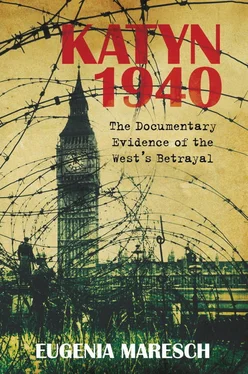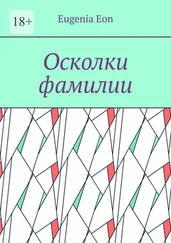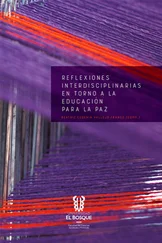Various documents reveal that the FO was unwilling to disclose to the American Committee any documents on Katyn, giving the excuse that even British MPs had no access to them as of right. [21] TNA FO 371/97632 ref U1661/22, minutes of the meeting between Mr Penfield and Mr R.C. Courtney both from the US Embassy and Mr Roderick Barclay of the FO 18 April 1952; PREM 11/311 record of conversation with the US Ambassador of Sir William Strang and Sir Roger Makins, 3 April 1952.
After prolonged consultations, Sir William Strang, the Permanent Secretary of State of the FO, stuck to this line until after the departure of the Congressmen from London. It can only be assumed that the reason for secrecy was the wartime operational method of contact between PoWs and MI 9 (British Military Intelligence (branch 9 of the War Office), which needed to be safeguarded. Some PoWs were able to write in code hidden in the text of normal correspondence and were able to receive broadcast radio transmissions on clandestine makeshift radio receivers. Captain G. Gorrie, RAMC, in Oflag V B , was one such code writer known to Gilder. Whatever the reasons for hushing up the existence of the only British report on Katyn, there was surely enough evidence collated at the East European and Soviet Department of the FO, to confirm that the perpetrators were indeed the Soviets. Yet, the five Katyn photographs taken by the Germans, which were deposited with Gilder’s report at the FO, were met with scepticism: ‘They tell us nothing except that we may be pretty sure, they were used for propaganda purposes.’ Regrettably, the photographs can no longer be traced among the WO files.
Gilder remembers the meeting he had with a Polish member of the Red Cross, who according to him was uncommunicative; while Wodziński clearly describes the conversation he had with Gilder. In the last sentence of his report, Gilder also downplays what he had seen at Katyn and the Germans seem to leave him alone.
In 1946, Skarżyński and Wodziński managed to escape the oppressive communist regime in Poland and reached the West. Wodziński made his deposition in Italy on 27 February 1946 and after his arrival in the UK, submitted testimony in September 1946, but his whereabouts were unknown until his death in 1986, registered in the UK by the Merseyside Borough of Sefton. Skarżyński settled comfortably in Canada and unlike Wodziński, took part in Congressional hearings of 1952. The whereabouts of Gilder were not followed up and we shall never know how he felt on reading van Vliet’s accounts in the newspapers, or in later years, each time the Katyn massacre was mentioned in Parliament or the press.
To keep the chronological flow of the events, the three reports by Skarżyński (translated by the author) Wodzinski (translator unknown) and Gilder are interwoven.
Kazimierz Skarżyński’s Report
On 9th April 1943, the President of the [ PCK ] Polish Red Cross, Wacław Lachert was summoned by telephone by Dr Heinrich, a delegate of the German Generalgouvernment to the Polish Red Cross, to present himself at a meeting in Brühl Palace, without indicating the purpose of the meeting. He refused to attend immediately offering to come in one hour; to which Heinrich replied that it would be too late and the substance of the meeting will be communicated to him later. The same day at 18.00 hours, Dr Heinrich telephoned the President, to tell him that it had been decided to send a delegation to Smolensk district to inspect the graves of Polish officers murdered by the Bolsheviks; he named the persons who would take part in the delegation: two literary writers [Ferdynand] Goetel and [Emil] Skiwski, a representative from the RGO (Council for Social Welfare) Dr [Edward] Grodzki, Dr [Konrad] Orzechowski from the Warsaw City Council and others, indicating that a place has been reserved also for the PCK President, in the aeroplane departing for Smolensk the next day at 8 o’clock. President Lachert himself and on behalf of the remaining members of the PCK Executive Committee, again refused to take part in the delegation due to its propagandist nature.
As it turned out, those mentioned above and a representative of the Roman Catholic Curia, who were at the meeting in Brühl Palace, heard the representative of the German Propagandaamt talk at length about a Polish-German understanding under the banner of the defence of Europe against the Bolsheviks, announcing to all present the discovery of the Katyn graves and the proposed departure to the place by a delegation. The representative of the Curia also declined to take part in the delegation. The previously unheard new tone of voice of the Propagandaamt delegate as well as the circumstances surrounding the sending of a delegation to Smolensk clearly indicated that the German authorities were aiming at drawing the Polish Red Cross into the orbit of the existing propaganda action. It was clear then, that the Katyn massacre as an object of propaganda for the Germans would grow on a grand scale to serve their political aims, which might create unexpected problems for the Polish Government. In the next few days, while waiting for the matter to unfold, these issues became a constant topic for discussions within the PCK Executive Committee. In the first instance, the Executive Committee reacted with great distrust to any news on Katyn that came from German sources. This was based on the daily occurrence of perverse and bestial treatment suffered under the German occupation of four years.
On 12 April [1943], a well-known writer, Ferdynand Goetel, a participant of the expedition staged by the German authorities with whom, up to now, the PCK had no close association, presented a report on his own initiative to the Executive Committee about his visit to Smolensk and Katyn. It was apparent from this first eyewitness report, which has not come from German sources, that he had seen a concealed mass grave of the Polish officers and that everything indicated that the murder took place in March–April 1940. The suspicion of a direct involvement by the Germans in the murders started to wane.
On the morning of 14 April, Dr Grundmann from the Propagandaamt in the Warsaw District turned up personally at the PCK office and gave a verbal summons to the President, urging him to send a delegation of five persons the same day at 13.00 hours to depart to Smolensk At the same time he stressed that the same plane was leaving Kraków with Mr [Stanisław] Plappert, a plenipotentiary of the Polish Red Cross Executive Committee of the Kraków District and his Deputy Dr [Adam] Schebesta, [22] Adam Edward Schebesta (1893–NN) studied medicine in Lwów and Vienna, chief Medical Officer, Lieutenant Colonel during 1920 War of Independence. In 1930 became a member of the Executive Committee of the Polish Red Cross in Kraków.
as well as representatives of the clergy sent by His Excellency the Bishop. We immediately tried to get in touch with Dr Schebesta in Kraków by telephone but he had already left the office. The Executive Committee had to face the fact that representation from Kraków’s PCK was already en route for Smolensk by order of the German authorities.
After a short discussion a decision was made, which became the basis of the PCK’s attitude with regard to the Katyn case. It was based on these premises:
1. A demand to send a delegation of the PCK Executive Committee should be absolutely opposed, as it could be used for German propaganda purposes and would directly serve its political aims, in which the PCK should not take any part and should detach itself from completely.
2. The identification of the bodies of the officers in the mass graves, both for the Information Office of the PCK and for thousands of Polish families, is vital.
Читать дальше












